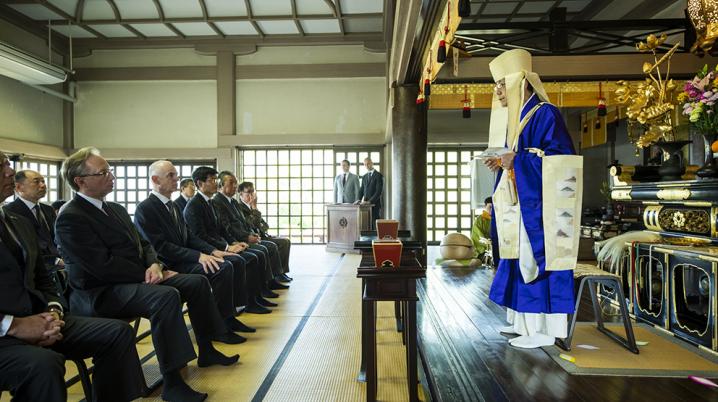
Japan: Restoration works on European historical cemetery
Goshinji Temple
Aart Jacobi, ambassador for the Netherlands in Japan, attended a special ceremony with his Russian colleague Mikhail Galuzin on 18 April. The occasion was the completion of the restoration works at the Dutch and Russian cemeteries in Nagasaki. They are both located on the grounds of the Goshinji Temple and share a large wall that was about to cave in. Aart Jacobi: “It was a special day. It took us three years and the project shows how shared historical heritage can bring two countries in a complex relation closer”.
Urgency
As for the wall, deputy head of Public Diplomacy, Political and Cultural Affairs Ton van Zeeland commented: “A specialised research by the Cultural Heritage Agency of the Netherlands in 2016 confirmed the urgency. The wall could collapse at any moment. From July 2016 onwards the two embassies have been in contact to coordinate the work. Together with my Russian counterpart I travelled several times to Nagasaki for meetings. This would not have been possible without coordination”.
Heritage Specialists
The restoration works of the wall on the Dutch side were coordinated by the Japan Netherlands Society of Nagasaki. The society received a contribution from the Shared Cultural Heritage programme’s budget of the embassy. The actual work started in November 2018. A new, enforced wall was placed behind the old wall ensuring a good foundation and support.
100 years old
The wall consisted of two parts: the 100-years-old brick wall around the Dutch cemetery and a Russian wall on top of it. The Dutch wall has historical value as it is and needs to be conserved, but the Russian wall could be replaced by a modern, lighter version. Ambassador Jacobi who held a speech during the ceremony: ‘A new green plan has been drawn up and new plants, trees and bushes were planted. The new plan has something abloom in every season. After the speeches I laid wreaths with my Russian colleague at both cemeteries.’
41 gravestones
The so-called ‘Hollandsche Begraafplaats’ (Dutch cemetery) was established in 1654. 41 stones remain today of which the earliest dates from 1778. The Russian cemetery is younger and dates back to 1858. Goshinji Temple is headed by Abbot Kizu and his family. He represents the 23th generation in the line of abbots who have guarded the souls of those interred.
A digital photobook of the ceremony with photos by Takumi Matsumura can be found here.

